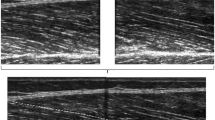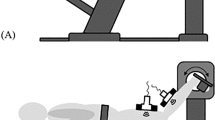Summary
The maximal strengths of knee extensor (E) and flexor (F) muscles were compared in a group of 6 male subjects aged 24–31 years.
Cross-sectional area (CSA) of E and F was evaluated from planimetric measurements of Nuclear Magnetic Resonance (NMR) imaging axial scans, carried out at five levels along the thigh. Maximal CSA for E was found at 2/3 upper femur height and at 1/3 lower femur height for F.
Maximum isometric force (MIF) of E was found to be 135% greater than that of F. The maximum CSA of E was found to be 93% larger than CSA of F.
The calculated mechanical advantage of the flexors was estimated to be 13.8% higher than that of the knee extensors (0.116±0.012 and 0.132±0.005, respectively). However, when MIF of E and F were standardised for their respective CSA, no significant difference was found between their stress: 80.1±15.5 N · cm−2 for E and 70.5±7.0 N · cm−2 for F.
From the present study, it is concluded that no significant difference exists between the maximum stress of knee extensor and flexor muscles despite large differences in their absolute values of force and CSA and that the NMR imaging technique enables accurate in-vivo determination of the CSA of individual muscles.
Similar content being viewed by others
References
Alexander RMcN, Vernon A (1975) The dimensions of knee and ankle muscles and the forces they exert. J Mov Stud 1:115–123
Ariano MA, Armstrong RB, Edgerton VR (1973) Hindlimb muscle fiber populations of five mammals. J Histochem Cytochem 21:51–55
Barany M, Close RI (1971) The transformation of myosin in cross-innervated rat muscles. J Physiol 213:455–474
Bodine SC, Roy RR, Meadows DA, Zernicke RF, Sacks RD, Fournier M, Edgerton VR (1982) Architectural, histochemical and contractile characteristics of a unique biarticular muscle: the cat semitendinous. J Neurophysiol 48:192–201
Close RI (1972) Dynamic properties of mammalian skeletal muscles. Physiol Rev 52:129–197
Fick R (1910) Handbuch der Anatomie und Mechanik der Gelenke unter Berücksichtigung der Bewegenden Muskeln. Fischer, Jena
Franke F (1920) Die Kraftkurve menschlicher Muskeln bei willkürlicher Innervation und die Frage der absoluten Muskelkraft. Pflügers Arch 184:300–322
Haxton HA (1944) Absolute muscle force in the ankle flexors of man. J Physiol 103:267–273
Hermann L (1898) Zur Messung der Muskelkraft am Menschen. Pflügers Arch 73:429–437
Heymsfield SB (1982) Anthropometric measurement of muscle mass: reused equations for calculating bone-free arm muscle area. Am J Clin Nutr 36:680–690
Ikai M, Fukunaga T (1968) Calculation of muscle strength per unit cross-sectional area of human muscle by means of ultrasonic measurement. Int Z Angew Physiol einschl Arbeitsphysiol 26:26–32
Jones PRM, Pearson J (1969) Anthropometric determination of leg fat and muscle plus bone volumes in young male and female adults. J Physiol 204:66P-67P
Knapik JJ, Ramos MU (1980) Isokinetic and isometric torque relationship in the human body. Arch Physiol Med Rehabil 61:64–67
Larsson L, Grimby G, Karlsson J (1979) Muscle strength and speed of movement in relation to age and muscle morphology. J Appl Physiol: Respirat Environ Exercise Physiol 46:451–456
Maughan RJ, Nimmo MA (1984) The influence of variations in muscle fibre composition on muscle strength and cross-sectional area in untrained males. J Physiol 351:299–311
Maughan RJ, Watson JS, Wier J (1983a) Strength and crosssectional area of human skeletal muscle. J Physiol 338:37–49
Maughan RJ, Watson JS, Weir J (1983) Relationship between muscle strength and muscle cross-sectional area in male sprinters and endurance runners. Eur J Appl Physiol 50:309–318
Mc Cullagh P, Maughan RJ, Watson JS, Wir J (1983) Biomechanical analysis of the knee in relation to the measured quadriceps strength and cross-sectional are in man. J Physiol 346:60P
Nygaard E, Houston M, Suzuki Y, Jorgensen K, Saltin B (1983) Morphology of the brachial biceps muscle and elbow flexion in man. Acta Physiol Scand 117:287–292
Ralston HJ, Polissar MG, Inman VT, Close JR, Feinstein B (1949) Dynamic features of human isolated voluntary muscle in isometric and free contractions. J Appl Physiol 1:526–533
Rays JHO (1915) Über die absolute Kraft der Muskeln im menschlichen Körper. Pflügers Arch 160:183–204
Saltin B, Gollnick PD (1983) Skeletal muscle adaptability: significance for metabolism and performance. In: Handbook of physiology, skeletal muscle, p 563
Schantz P, Randall-Fox P, Hutchinson W, Tidén A, Astrand PO (1983) Muscle fibre type distribution, muscle cross-sectional area and maximal voluntary strength in humans. Acta Physiol Scand 117:219–226
Simonson E, Lind AR (1971) Fatigue in static work. In: Simonson E (Ed) Physiology of work capacity and fatigue. Charles C Thomas, Springfield Ill, pp 241–284
Smidt GL (1973) Biomechanical analysis of knee flexion and extension. J Biomech 6:79–92
Spector SA, Gardiner PF, Zernicke RF, Roy RR, Edgerton VR (1980) Muscle architecture and force-velocity characteristics of cat soleus and medial gastrocnemius: implication for motor control. J Neurophysiol 44:951–960
Thorstensson A, Grimby G, Karlsson J (1976) Force-velocity relations and fibre composition in human knee extensor muscles. J Appl Physiol 40:12–16
Tsunoda N, Ikegaua S, Yata H, Kondo M, Kanehisa H, Fukunaga T, Asami T (1985) Structural and functional characteristics of thigh muscle in athletes. In: Biomechanics IXA, Human Kinetics Publishers, Champaigne-Ill, pp 15–20
Weber E (1846) Wagner's Handwörterbuch der Physiologie. Vieweg, Braunschweig
Wickiewicz TL, Roy RR, Powell PL, Perrine JJ, Edgerton VR (1984) Muscle architecture and force-velocity relationships in humans. J Appl Physiol 57:435–443
Author information
Authors and Affiliations
Rights and permissions
About this article
Cite this article
Narici, M.V., Roi, G.S. & Landoni, L. Force of knee extensor and flexor muscles and cross-sectional area determined by nuclear magnetic resonance imaging. Europ. J. Appl. Physiol. 57, 39–44 (1988). https://doi.org/10.1007/BF00691235
Accepted:
Issue Date:
DOI: https://doi.org/10.1007/BF00691235




